LAB REPORT
Science and Technology Making Headlines
Aug. 14, 2020

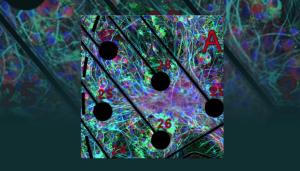
A Lawrence Livermore National Laboratory team cultured rodent-derived neurons on microelectrode arrays and allowed the cultures to form networks, supplementing them with astrocytes and oligodendrocytes. Pictured is an immunofluorescence image of a complex culture, showing neurons (stained red), astrocytes (cyan) and oligodendrocytes (green).
This is your brain on a chip
Lawrence Livermore National Laboratory (LLNL) researchers have increased the complexity of neuronal cultures grown on microelectrode arrays, a key step toward more accurately reproducing the cellular composition of the human brain outside the body.
An LLNL team led by biomedical scientist Heather Enright cultured rodent-derived neurons on microelectrode arrays on a two-dimensional "brain-on-chip" device. They allowed the neuronal cultures to form networks, supplementing them with other cell types found in the brain — astrocytes and oligodendrocytes — which play a critical role in neuronal health and function.
For more than a month in culture, the team monitored the neurons’ electrical activity and characterized their molecular profile as they grew and matured over time. Researchers said the study establishes key differences between neuronal cultures of varying complexity, which will allow them to more accurately mimic the behavior of an animal brain in three-dimensional in vitro devices.
"It was clear from what we had done in the earlier work that we needed to enhance the cellular complexity of these devices to more accurately recapitulate the function of the brain in an animal system," Enright said. "The goal was to include these other key cell types in ratios that were relevant. We hypothesized that the neurons in these complex cultures would behave similarly as they do in the brain, and we did see some indication of that."

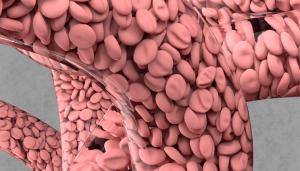
A simulation of arterial blood flow using HARVEY, a fluid dynamics software developed by Lawrence Fellow Amanda Randles. Visualization by Liam Krauss/LLNL.
Getting to the heart of defects
One of the most common congenital heart defects, coarctation of the aorta (CoA) is a narrowing of the main artery transporting blood from the heart to the rest of the body. It affects more than 1,600 newborns each year in the United States, and can lead to health issues such as hypertension, premature coronary artery disease, aneurysms, stroke and cardiac failure.
To better understand risk factors for people with CoA, a large team of researchers, including a former Lawrence Fellow and her mentor at Lawrence Livermore, have combined machine learning, 3D printing and high performance computing simulations to accurately model blood flow in the aorta. Using the models, validated on 3D-printed vasculature, the team was able to predict the impact of physiological factors such as exertion, elevation and even pregnancy on CoA, which forces the heart to pump harder to get blood to the body.
Proposed as an Institutional Computing Grand Challenge project at LLNL by then-Lawrence Fellow Amanda Randles (now the Mordecai assistant professor of biomedical sciences at Duke University) and her mentor, LLNL computer scientist Erik Draeger, the work represents the largest simulation study to date of CoA, involving more than 70 million compute hours of 3D simulations done on LLNL’s Blue Gene/Q Vulcan supercomputer.

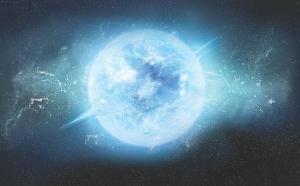
New LLNL research lends insight into white dwarfs, which are the final stage of evolution for most stars.
You call it an evolution
Using the power of the National Ignition Facility, the world's highest-energy laser system, researchers at Lawrence Livermore National Laboratory and an international team of collaborators have recorded equation of state measurements that shed light on stellar evolution.
The team developed an experimental capability for measuring the basic properties of matter, such as the equation of state (EOS), at the highest pressures thus far achieved in a controlled laboratory experiment.
The results are relevant to the conditions at the cores of giant planets, the interiors of brown dwarfs (failed stars), the carbon envelopes of white dwarf stars and many applied science programs at LLNL.
The overlap with white dwarf envelopes is particularly significant. This new research enables experimental benchmarks of the basic properties of matter in this regime. The results should ultimately lead to improved models of white dwarfs, which represent the final stage of evolution for most stars in the universe.

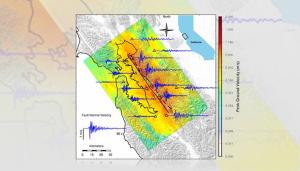
Simulated strength of shaking from a magnitude 7.0 Hayward Fault earthquake showing peak ground velocity (colorbar) and seismograms (blue) at selected locations (triangles).
Whole lotta shaking
A Lawrence Livermore team has published new supercomputer simulations of a magnitude 7.0 earthquake on the Hayward Fault. This work represents the highest-ever resolution ground motion simulations from such an event on this scale.
The study used the SW4 code developed at LLNL. Simulations resolved rapidly varying shaking with broader band frequencies up to 10 Hz, doubling resolution of previous runs. Seismic waves as short as 50 meters were resolved across a regional-scale domain covering the San Francisco Bay Area from Napa to San Jose and the Sacramento-San Joaquin Delta to the Pacific Ocean. Previous simulations lacked the performance and memory to model such high frequency motions on such a large domain.
High-frequency shaking is critical for evaluating seismic hazards and the risk of damage to the built environment, such as buildings, homes, transportation and utility lifelines.

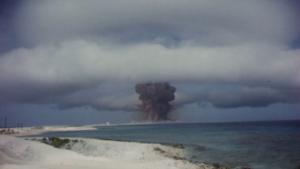
Operation Hardtack I was a series of 35 nuclear tests conducted by the United States from April 28 to Aug. 18 in 1958 at the Pacific Proving Grounds.
Hollywood is the bomb
If Hollywood isn't making new nuclear films, some old ones have recently surfaced — declassified just as they were turning to dust. They're footage shot by military researchers of nuclear tests conducted between 1945 and 1962.
More than 100 are available for viewing on YouTube from Lawrence Livermore National Laboratory, which is analyzing them with computers and discovering that the readings made by scientists decades ago — readings on which computer simulations of current weaponry are based — are off by as much as 30 percent.
Their mushroom clouds are breathtaking, the power they document unfathomable. And then you realize the point of digitizing them is to help modernize nuclear stockpiles and keep the deterrent safe and secure.





